If you enjoy vibrant, Italian-inspired flavors, you’ll love this easy grilled chicken margherita recipe. Think of it as a twist on margherita pizza but served on top of juicy chicken instead of dough. Fresh tomato, fragrant basil, and mozzarella cheese come together for an irresistible meal. The tang of pesto, the creaminess of melted mozzarella, and the brightness of ripe tomatoes create an unforgettable combination.
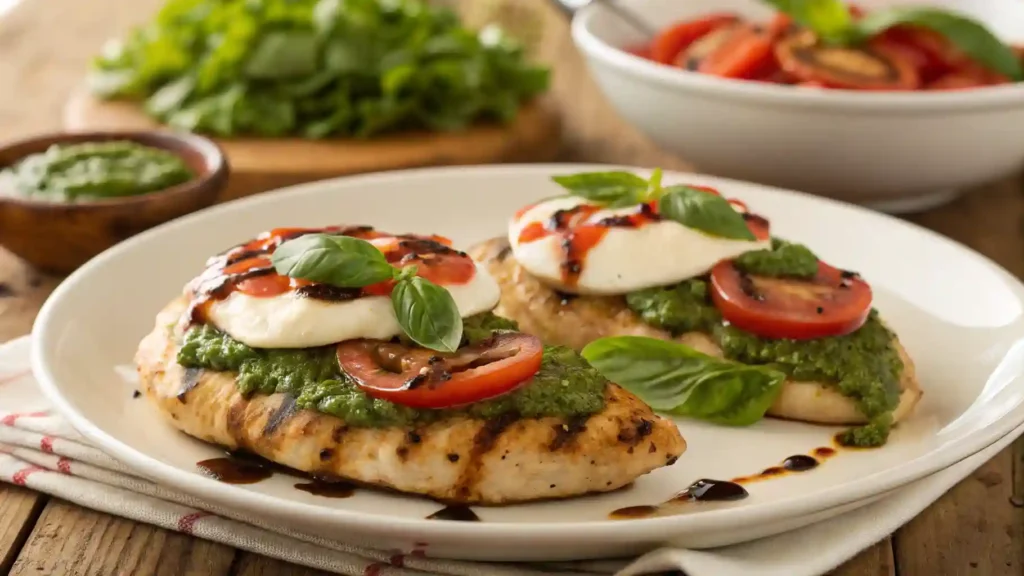
People often crave a chicken recipe that feels lighter than a fried dish. That’s where the grill comes in handy. When you grill chicken, you lock in moisture without loading on excess oil. This approach yields juicy grilled chicken that works well for lunches, dinners, or even meal prep. You can also add a drizzle of balsamic glaze for a zesty finishing touch.
Table of Contents
Why You’ll Love This Recipe
There’s something special about blending those traditional Italian flavors with the smoky taste you get when you grill chicken. If you’re still undecided on whether this meal belongs in your recipes to try list, here are a few points that might persuade you:
- Fresh Ingredients: This dish leans on the synergy of fresh tomato, basil, and cheese. These items, especially when served over a juicy chicken breast, appeal to fans of margherita pizza flavors but with far fewer carbs than pizza crust.
- Simple but Delicious: While the dish sounds impressive, it’s relatively easy to create. Even if you’re new to cooking, the steps are straightforward. It’s a prime example of easy chicken recipes that still feel fancy enough for guests.
- Juicy Chicken: The key to success is choosing boneless or boneless skinless chicken and ensuring you cook it to an internal temperature of 165°F. This locks in moisture and ensures each piece of chicken tastes flavorful. Careful grilling prevents dryness.
- Versatility: You can serve your finished margherita chicken over pasta, pair it with salad, or tuck it into a sandwich. The dish transitions seamlessly from casual lunches to more formal dinner parties, earning it a spot among your favorite dinner recipes.
Ingredients
In this grilled chicken margherita recipe, the ingredients reflect the simplicity and classic flavors you might find in an olive garden setting, but you can make them at home. Use fresh items whenever possible because that helps each bite sing with taste. Here is the full list:
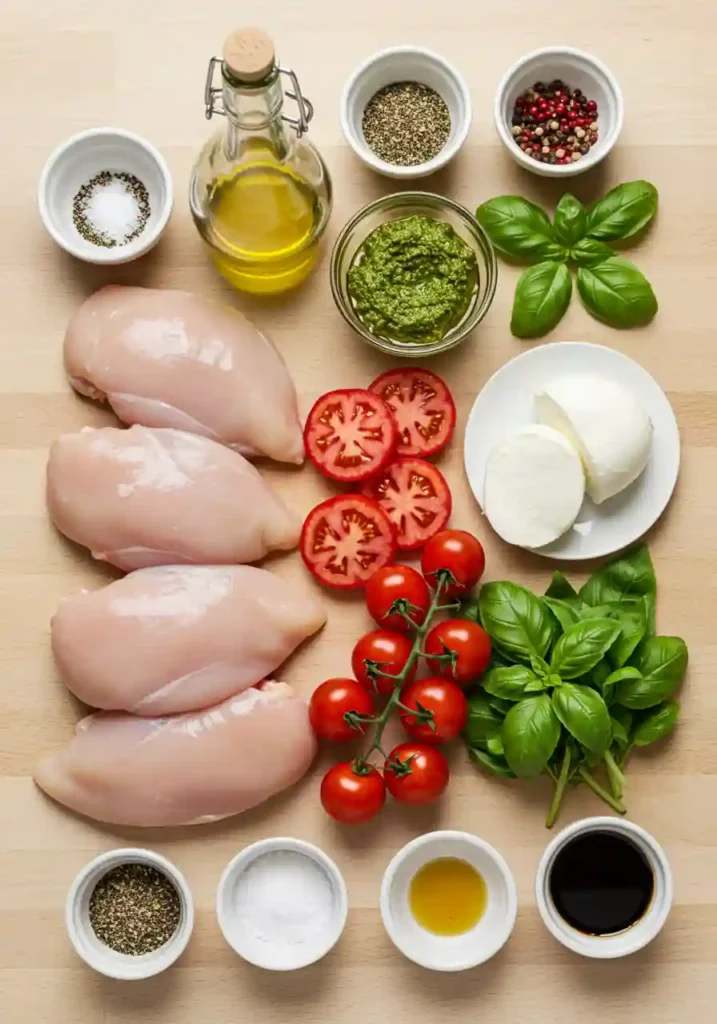
- Boneless Skinless Chicken Breasts (4 pieces)
- Choosing boneless poultry makes the process faster. Go for medium-sized ones around six to eight ounces each. If they’re large, you can butterfly them, then pound the chicken to an even thickness for consistent cooking times.
- Choosing boneless poultry makes the process faster. Go for medium-sized ones around six to eight ounces each. If they’re large, you can butterfly them, then pound the chicken to an even thickness for consistent cooking times.
- Pesto (½ cup total)
- You can use homemade pesto or store-bought pesto, whichever is convenient. If you want something extra special, try making your own homemade basil pesto by blending fresh basil leaves, olive oil, pine nuts, parmesan, and minced garlic. If time is short, a jar of your favorite brand works well. This dish is also fantastic if you add a quick tablespoon of pesto to marinade, enhancing flavor from the start.
- You can use homemade pesto or store-bought pesto, whichever is convenient. If you want something extra special, try making your own homemade basil pesto by blending fresh basil leaves, olive oil, pine nuts, parmesan, and minced garlic. If time is short, a jar of your favorite brand works well. This dish is also fantastic if you add a quick tablespoon of pesto to marinade, enhancing flavor from the start.
- Tomato (2 large or 1 cup of chopped pieces)
- Go for ripe tomatoes with good color and no bruises. Roma or plum tomatoes work best. If you prefer smaller ones, cherry tomatoes also work well. You can slice them or chop them, depending on how you plan to top each chicken breast.
- Go for ripe tomatoes with good color and no bruises. Roma or plum tomatoes work best. If you prefer smaller ones, cherry tomatoes also work well. You can slice them or chop them, depending on how you plan to top each chicken breast.
- Fresh Basil (handful)
- While you can use dried basil if that’s all you have, fresh basil leaves create a more distinct aroma and color. You’ll need them for a final garnish and for mixing into the marinade if you want extra herbiness.
- While you can use dried basil if that’s all you have, fresh basil leaves create a more distinct aroma and color. You’ll need them for a final garnish and for mixing into the marinade if you want extra herbiness.
- Olive Oil (2 tablespoons)
- Some will go into the marinade, and a bit may be brushed onto the grill grates if needed to help prevent sticking. Aim for extra virgin if possible, but any will do.
- Some will go into the marinade, and a bit may be brushed onto the grill grates if needed to help prevent sticking. Aim for extra virgin if possible, but any will do.
- Mozzarella Cheese (4 slices)
- You can opt for fresh mozzarella or slice of mozzarella cheese from a block. This detail depends on preference. If you want the classic melty finish, look for something labeled as “low-moisture mozzarella” that melts more consistently. Alternatively, use a ball of fresh mozzarella for a creamy bite.
- You can opt for fresh mozzarella or slice of mozzarella cheese from a block. This detail depends on preference. If you want the classic melty finish, look for something labeled as “low-moisture mozzarella” that melts more consistently. Alternatively, use a ball of fresh mozzarella for a creamy bite.
- Balsamic (optional, 2 tablespoons)
- Some folks enjoy a drizzle of balsamic glaze or a swirl of plain balsamic vinegar. This adds tang and pairs nicely with the tomato and pesto sauce. You can also reduce it on the stovetop with a dash of sugar if you want a thicker glaze.
- Some folks enjoy a drizzle of balsamic glaze or a swirl of plain balsamic vinegar. This adds tang and pairs nicely with the tomato and pesto sauce. You can also reduce it on the stovetop with a dash of sugar if you want a thicker glaze.
- Italian Seasoning (1 tablespoon)
- This blend typically includes oregano, thyme, rosemary, and marjoram. It adds depth and quick flavor to your marinade. Some like a pinch more thyme or a sprinkle of garlic powder to tailor it.
- This blend typically includes oregano, thyme, rosemary, and marjoram. It adds depth and quick flavor to your marinade. Some like a pinch more thyme or a sprinkle of garlic powder to tailor it.
- Salt and Pepper (to taste)
- Basic seasoning. A pinch of each is enough. You might also add black pepper to the marinade for a sharper bite.
- Basic seasoning. A pinch of each is enough. You might also add black pepper to the marinade for a sharper bite.
- Optional Extra Herbs
- If you like a stronger herb chicken flavor, sprinkle some extra leaves of fresh basil or additional dried oregano. You can also try a dash of lemon zest if you enjoy bright citrus undertones.
- If you like a stronger herb chicken flavor, sprinkle some extra leaves of fresh basil or additional dried oregano. You can also try a dash of lemon zest if you enjoy bright citrus undertones.
Instructions
Here is the heart of the recipe, broken down into clear steps so you can make grilled chicken margherita without stress. These instructions help you cook the chicken perfectly while layering on those classic tomato-basil notes.
Note: You can adapt these steps if you need to use a skillet on the stovetop. However, you won’t get the same smoky taste you get when you grill chicken outdoors.
Step 1: Marinate the Chicken
- Marinate (Optional but Recommended)
- If you have time, marinate the chicken. In a zip-top bag or shallow dish, combine the boneless skinless chicken breasts with 1 tablespoon of olive oil, a tablespoon of pesto, some chopped fresh basil, salt and pepper, and italian seasoning. This helps the chicken absorb more flavor before it hits the grill.
- Marinate for 30 minutes, or up to 2 hours in the fridge.
- If you have time, marinate the chicken. In a zip-top bag or shallow dish, combine the boneless skinless chicken breasts with 1 tablespoon of olive oil, a tablespoon of pesto, some chopped fresh basil, salt and pepper, and italian seasoning. This helps the chicken absorb more flavor before it hits the grill.
- Pound the Chicken (If Needed)
- If your chicken is uneven in thickness, use a meat mallet or rolling pin to gently pound the chicken. This ensures even thickness, helping each piece of chicken cook evenly and preventing dry edges.
- If your chicken is uneven in thickness, use a meat mallet or rolling pin to gently pound the chicken. This ensures even thickness, helping each piece of chicken cook evenly and preventing dry edges.
Step 2: Preheat and Prepare the Grill
- Preheat
- Turn on your gas grill or charcoal grill to medium-high heat. Aim for around 375°F to 400°F. This temperature range helps you achieve a sear while keeping the inside moist.
- Turn on your gas grill or charcoal grill to medium-high heat. Aim for around 375°F to 400°F. This temperature range helps you achieve a sear while keeping the inside moist.
- Oil the Grill Grates
- If you’re worried about sticking, lightly oil the grill grates with a bit of olive oil on a paper towel. This step helps reduce the chance of tearing the chicken when flipping.
- If you’re worried about sticking, lightly oil the grill grates with a bit of olive oil on a paper towel. This step helps reduce the chance of tearing the chicken when flipping.
- Gather Other Ingredients
- As the grill heats, slice your tomato or cherry tomatoes. Set aside the fresh mozzarella or your chosen cheese type. Have your additional pesto ready for later. When everything is in place, you can move quickly once the chicken is nearly done.
- As the grill heats, slice your tomato or cherry tomatoes. Set aside the fresh mozzarella or your chosen cheese type. Have your additional pesto ready for later. When everything is in place, you can move quickly once the chicken is nearly done.
Step 3: Grill the Chicken
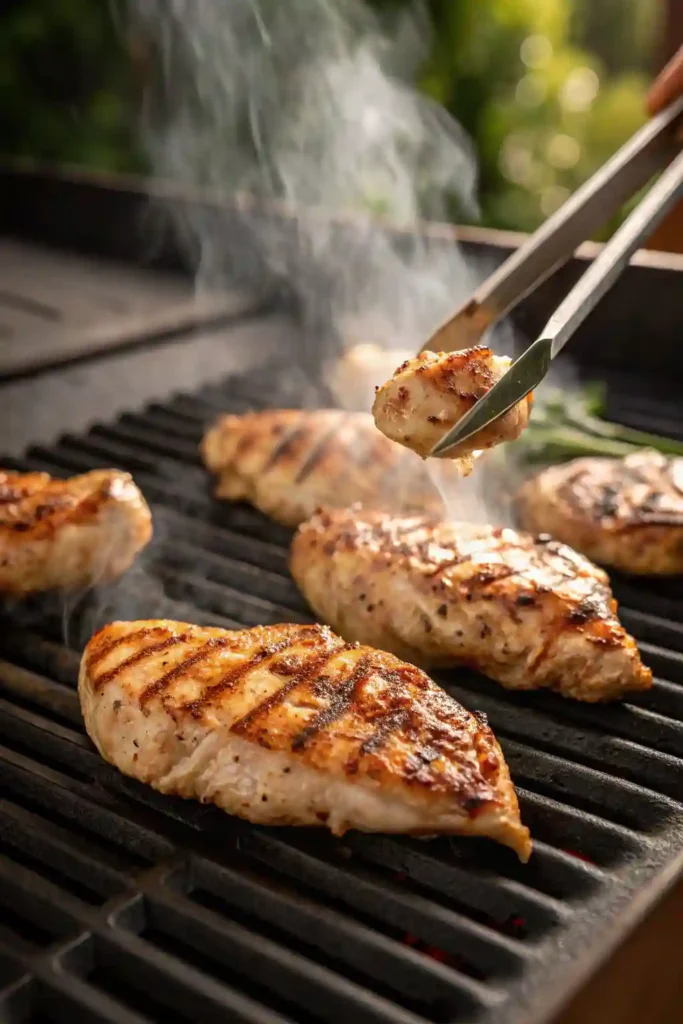
- Add the Chicken
- Place the chicken breasts on the hot grill. Discard any leftover marinade for food safety. Let them cook, undisturbed, to develop flavor and grill marks.
- Place the chicken breasts on the hot grill. Discard any leftover marinade for food safety. Let them cook, undisturbed, to develop flavor and grill marks.
- Cook the Chicken
- Let them cook for about 5-6 minutes on one side, depending on thickness. If your breasts are thinner, it might only take 3-4 minutes. You want a slight golden hue and a bit of color around the edges.
- Let them cook for about 5-6 minutes on one side, depending on thickness. If your breasts are thinner, it might only take 3-4 minutes. You want a slight golden hue and a bit of color around the edges.
- Flip the Chicken
- Carefully flip the chicken using tongs. Grill the opposite side for another 5-6 minutes or until the internal temperature reaches around 160°F. Don’t worry, it will come up to 165°F after resting.
- Resist moving the pieces too often, as it interferes with getting a good sear.
- Carefully flip the chicken using tongs. Grill the opposite side for another 5-6 minutes or until the internal temperature reaches around 160°F. Don’t worry, it will come up to 165°F after resting.
- Check Internal Temperature
- Use a meat thermometer to confirm that the chicken is cooked through. The safe internal temperature is 165°F. Some people remove at 160°F and let carryover heat bring it to the final stage. Overcooking can make the chicken rubbery, so keep a close eye.
- Use a meat thermometer to confirm that the chicken is cooked through. The safe internal temperature is 165°F. Some people remove at 160°F and let carryover heat bring it to the final stage. Overcooking can make the chicken rubbery, so keep a close eye.
Step 4: Top Each Chicken Breast with Margherita Goodness
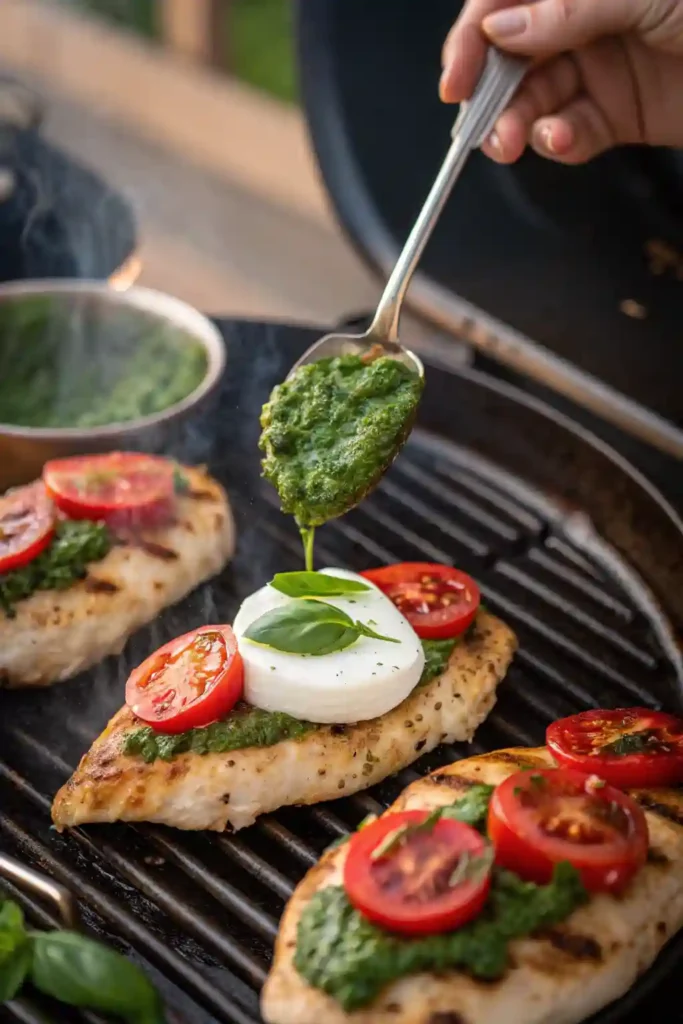
- Add the Pesto
- Remove the chicken from direct heat or move it to a cooler side of the grill. Spread a spoonful of pesto on top of the chicken, effectively turning it into pesto chicken. Smooth it out for even coverage. This step is crucial to building that classic flavor.
- Remove the chicken from direct heat or move it to a cooler side of the grill. Spread a spoonful of pesto on top of the chicken, effectively turning it into pesto chicken. Smooth it out for even coverage. This step is crucial to building that classic flavor.
- Top of the Chicken
- Spoon or arrange tomato slices on each piece. Then lay a slice of mozzarella (or fresh mozzarella) carefully over the tomatoes. If you prefer diced tomatoes or fresh tomatoes in chunks, that works too.
- Spoon or arrange tomato slices on each piece. Then lay a slice of mozzarella (or fresh mozzarella) carefully over the tomatoes. If you prefer diced tomatoes or fresh tomatoes in chunks, that works too.
- Close the Lid
- Close the lid of the grill for about one minute. This helps the cheese melt properly. Once you see melted mozzarella, you can pull the chicken off the heat.
- Close the lid of the grill for about one minute. This helps the cheese melt properly. Once you see melted mozzarella, you can pull the chicken off the heat.
- Add the Cheese
- If you want extra gooey results, you can add more mozzarella. Some people prefer multiple slices for a super cheesy effect. The key is not to burn the bottom, so watch carefully.
- If you want extra gooey results, you can add more mozzarella. Some people prefer multiple slices for a super cheesy effect. The key is not to burn the bottom, so watch carefully.
Step 5: Remove and Rest
- Remove the Chicken
- Once the cheese is melted, take your grilled chicken topped with tomato and pesto off the grill. Transfer the poultry to a plate or tray and let it rest for a couple of minutes. This pause keeps the juices intact. You can drizzle a bit of balsamic or balsamic glaze if you wish.
- Once the cheese is melted, take your grilled chicken topped with tomato and pesto off the grill. Transfer the poultry to a plate or tray and let it rest for a couple of minutes. This pause keeps the juices intact. You can drizzle a bit of balsamic or balsamic glaze if you wish.
Congratulations! You have grilled chicken margherita that’s perfect for a family meal or a romantic dinner. The bright tomato-basil flavor stands out, and the cheese adds a creamy note reminiscent of a pizza on top of a succulent chicken breast.
Pro Tips and Variations
To make this dish truly your own, consider the following tips, tricks, and spins:
- Use Chicken Thighs
- If you prefer dark meat, you can use chicken thighs instead. They often stay moist due to slightly higher fat content. Just keep an eye on cooking times, as thighs might need a bit more or less time based on thickness.
- If you prefer dark meat, you can use chicken thighs instead. They often stay moist due to slightly higher fat content. Just keep an eye on cooking times, as thighs might need a bit more or less time based on thickness.
- Try a Skillet
- If you don’t have access to a grill, use a skillet or grill pan on the stovetop. You can still grill chicken in a sense by using a grill pan or ridged skillet for some char and texture. You may not get the full smoky taste, but the results remain delicious.
- If you don’t have access to a grill, use a skillet or grill pan on the stovetop. You can still grill chicken in a sense by using a grill pan or ridged skillet for some char and texture. You may not get the full smoky taste, but the results remain delicious.
- Marinate the Chicken Longer
- If you want richer flavor, feel free to marinate overnight. You can incorporate a little lemon juice or lemon garlic sauce in the marinade to add brightness. This can create especially juicy chicken.
- If you want richer flavor, feel free to marinate overnight. You can incorporate a little lemon juice or lemon garlic sauce in the marinade to add brightness. This can create especially juicy chicken.
- Experiment with Cheese
- While fresh mozzarella is standard, you can use other cheeses. Some folks like provolone or a low-fat mozzarella option. If you do, watch how it melts. You can also try a sprinkle of parmesan for added sharpness.
- While fresh mozzarella is standard, you can use other cheeses. Some folks like provolone or a low-fat mozzarella option. If you do, watch how it melts. You can also try a sprinkle of parmesan for added sharpness.
- Drizzle Balsamic
- A quick swirl of balsamic or a honey-balsamic reduction can take the flavors up a notch. The acidity brightens the entire dish, especially if you prefer a tangy finish.
- A quick swirl of balsamic or a honey-balsamic reduction can take the flavors up a notch. The acidity brightens the entire dish, especially if you prefer a tangy finish.
- Use Extra Basil
- If you’re a basil fanatic, add chopped or torn fresh basil leaves right before serving. This pop of green can also garnish the plate, tying it all together visually.
- If you’re a basil fanatic, add chopped or torn fresh basil leaves right before serving. This pop of green can also garnish the plate, tying it all together visually.
- Focus on Internal Temperature
- Overcooking is the most common mistake. Use a thermometer to keep track. Once you see the internal temperature approach 165°F, you’re good to go. Undercooking is unsafe, so check carefully.
- Overcooking is the most common mistake. Use a thermometer to keep track. Once you see the internal temperature approach 165°F, you’re good to go. Undercooking is unsafe, so check carefully.
- Herb Chicken Variation
- Swap out pesto for an herb chicken marinade by including thyme, rosemary, and oregano with a splash of lemon juice. Then top it with sliced tomato and fresh mozzarella for a different angle on the same concept.
- Swap out pesto for an herb chicken marinade by including thyme, rosemary, and oregano with a splash of lemon juice. Then top it with sliced tomato and fresh mozzarella for a different angle on the same concept.
Serving Suggestions
Now that you have this grilled margherita chicken fresh off the grill, how do you serve it? Here are a few ideas:
- Over Pasta
- Tuck each breast on a bed of spaghetti or angel hair pasta. Spoon extra pesto sauce or sauce from the marinade over the noodles. Finish with a sprinkle of parmesan.
- Tuck each breast on a bed of spaghetti or angel hair pasta. Spoon extra pesto sauce or sauce from the marinade over the noodles. Finish with a sprinkle of parmesan.
- With Fresh Salad
- Keep it light and pair the chicken with a leafy green salad. You can use spinach, arugula, or romaine. Add sliced cucumbers, olives, or a balsamic vinaigrette for a balanced meal.
- Keep it light and pair the chicken with a leafy green salad. You can use spinach, arugula, or romaine. Add sliced cucumbers, olives, or a balsamic vinaigrette for a balanced meal.
- With Grilled Veggies
- You already have your grill on. Toss zucchini, eggplant, or peppers with olive oil and italian seasoning. Cook them for a few minutes per side to round out the plate.
- You already have your grill on. Toss zucchini, eggplant, or peppers with olive oil and italian seasoning. Cook them for a few minutes per side to round out the plate.
- In a Sandwich
- If you want a hearty lunch, place a piece of grilled chicken breast in a ciabatta roll or focaccia. Top it with lettuce, more tomatoes and basil, and maybe a drizzle of sauce. It becomes a handheld feast.
- If you want a hearty lunch, place a piece of grilled chicken breast in a ciabatta roll or focaccia. Top it with lettuce, more tomatoes and basil, and maybe a drizzle of sauce. It becomes a handheld feast.
- Side of Potatoes
- You can roast or mash potatoes as a comforting side. The starchy base pairs well with the tang of the tomato. A quick olive oil and herb blend on roasted potatoes is always a hit.
- You can roast or mash potatoes as a comforting side. The starchy base pairs well with the tang of the tomato. A quick olive oil and herb blend on roasted potatoes is always a hit.
- With Rice or Quinoa
- Some prefer a grain base for a balanced plate. Spoon leftover marinade or juices over the grains for extra flavor.
- Some prefer a grain base for a balanced plate. Spoon leftover marinade or juices over the grains for extra flavor.
Conclusion
This grilled chicken margherita recipe celebrates the timeless combination of tomato, fresh basil, and cheese—reminiscent of margherita pizza but lighter. By grilling, you highlight the natural flavors of boneless skinless chicken while keeping it moist. A dab of pesto or basil pesto enhances each bite with herbal goodness.
When you place the chicken on your plate, you’ll see how each layer contributes to the final taste. The tender poultry sets the stage, the tomato slices add brightness, and the melty mozzarella unifies everything into a single comforting meal. If you’re an olive garden fan, or you simply like to replicate restaurant experiences at home, this approach satisfies those cravings without stepping outside your kitchen.
If you want to grill chicken more often, let this dish be your gateway. It’s a grilled chicken recipe you’ll come back to again and again. It also proves that you can enjoy robust Italian flavors without frying or adding too many heavy sauces. Instead, this is your chance to appreciate fresh produce and high-quality ingredients. It’s an approach that honors the spirit of margherita chicken while keeping things easy to manage.
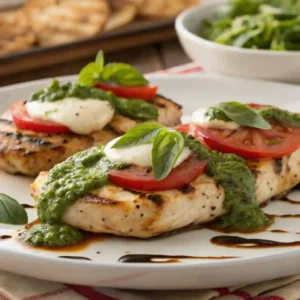
Grilled Chicken Margherita
Ingredients
Boneless Skinless Chicken Breasts (4 pieces)
- Choosing boneless poultry makes the process faster. Go for medium-sized ones around six to eight ounces each. If they’re large you can butterfly them, then pound the chicken to an even thickness for consistent cooking times.
Pesto (½ cup total)
- You can use homemade pesto or store-bought pesto whichever is convenient. If you want something extra special, try making your own homemade basil pesto by blending fresh basil leaves, olive oil, pine nuts, parmesan, and minced garlic. If time is short, a jar of your favorite brand works well. This dish is also fantastic if you add a quick tablespoon of pesto to marinade, enhancing flavor from the start.
Tomato (2 large or 1 cup of chopped pieces)
- Go for ripe tomatoes with good color and no bruises. Roma or plum tomatoes work best. If you prefer smaller ones cherry tomatoes also work well. You can slice them or chop them, depending on how you plan to top each chicken breast.
Fresh Basil (handful)
- While you can use dried basil if that’s all you have fresh basil leaves create a more distinct aroma and color. You’ll need them for a final garnish and for mixing into the marinade if you want extra herbiness.
Olive Oil (2 tablespoons)
- Some will go into the marinade and a bit may be brushed onto the grill grates if needed to help prevent sticking. Aim for extra virgin if possible, but any will do.
Mozzarella Cheese (4 slices)
- You can opt for fresh mozzarella or slice of mozzarella cheese from a block. This detail depends on preference. If you want the classic melty finish look for something labeled as “low-moisture mozzarella” that melts more consistently. Alternatively, use a ball of fresh mozzarella for a creamy bite.
Balsamic (optional, 2 tablespoons)
- Some folks enjoy a drizzle of balsamic glaze or a swirl of plain balsamic vinegar. This adds tang and pairs nicely with the tomato and pesto sauce. You can also reduce it on the stovetop with a dash of sugar if you want a thicker glaze.
Italian Seasoning (1 tablespoon)
- This blend typically includes oregano thyme, rosemary, and marjoram. It adds depth and quick flavor to your marinade. Some like a pinch more thyme or a sprinkle of garlic powder to tailor it.
Salt and Pepper (to taste)
- Basic seasoning. A pinch of each is enough. You might also add black pepper to the marinade for a sharper bite.
Optional Extra Herbs
- If you like a stronger herb chicken flavor sprinkle some extra leaves of fresh basil or additional dried oregano. You can also try a dash of lemon zest if you enjoy bright citrus undertones.
Instructions
Step 1: Marinate the Chicken
- Marinate (Optional but Recommended)
- If you have time, marinate the chicken. In a zip-top bag or shallow dish, combine the boneless skinless chicken breasts with 1 tablespoon of olive oil, a tablespoon of pesto, some chopped fresh basil, salt and pepper, and italian seasoning. This helps the chicken absorb more flavor before it hits the grill.
- Marinate for 30 minutes, or up to 2 hours in the fridge.
- Pound the Chicken (If Needed)
- If your chicken is uneven in thickness, use a meat mallet or rolling pin to gently pound the chicken. This ensures even thickness, helping each piece of chicken cook evenly and preventing dry edges.
Step 2: Preheat and Prepare the Grill
- Preheat
- Turn on your gas grill or charcoal grill to medium-high heat. Aim for around 375°F to 400°F. This temperature range helps you achieve a sear while keeping the inside moist.
- Oil the Grill Grates
- If you’re worried about sticking, lightly oil the grill grates with a bit of olive oil on a paper towel. This step helps reduce the chance of tearing the chicken when flipping.
- Gather Other Ingredients
- As the grill heats, slice your tomato or cherry tomatoes. Set aside the fresh mozzarella or your chosen cheese type. Have your additional pesto ready for later. When everything is in place, you can move quickly once the chicken is nearly done.
Step 3: Grill the Chicken
- Add the Chicken
- Place the chicken breasts on the hot grill. Discard any leftover marinade for food safety. Let them cook, undisturbed, to develop flavor and grill marks.
- Cook the Chicken
- Let them cook for about 5-6 minutes on one side, depending on thickness. If your breasts are thinner, it might only take 3-4 minutes. You want a slight golden hue and a bit of color around the edges.
- Flip the Chicken
- Carefully flip the chicken using tongs. Grill the opposite side for another 5-6 minutes or until the internal temperature reaches around 160°F. Don’t worry, it will come up to 165°F after resting.
- Resist moving the pieces too often, as it interferes with getting a good sear.
- Check Internal Temperature
- Use a meat thermometer to confirm that the chicken is cooked through. The safe internal temperature is 165°F. Some people remove at 160°F and let carryover heat bring it to the final stage. Overcooking can make the chicken rubbery, so keep a close eye.
Step 4: Top Each Chicken Breast with Margherita Goodness
- Add the Pesto
- Remove the chicken from direct heat or move it to a cooler side of the grill. Spread a spoonful of pesto on top of the chicken, effectively turning it into pesto chicken. Smooth it out for even coverage. This step is crucial to building that classic flavor.
- Top of the Chicken
- Spoon or arrange tomato slices on each piece. Then lay a slice of mozzarella (or fresh mozzarella) carefully over the tomatoes. If you prefer diced tomatoes or fresh tomatoes in chunks, that works too.
- Close the Lid
- Close the lid of the grill for about one minute. This helps the cheese melt properly. Once you see melted mozzarella, you can pull the chicken off the heat.
- Add the Cheese
- If you want extra gooey results, you can add more mozzarella. Some people prefer multiple slices for a super cheesy effect. The key is not to burn the bottom, so watch carefully.
Step 5: Remove and Rest
- Remove the Chicken
- Once the cheese is melted, take your grilled chicken topped with tomato and pesto off the grill. Transfer the poultry to a plate or tray and let it rest for a couple of minutes. This pause keeps the juices intact. You can drizzle a bit of balsamic or balsamic glaze if you wish.
Notes
FAQs
Below are answers to the most common questions about grilled chicken margherita and related cooking techniques:
What is a grilled chicken Margherita?
A grilled chicken Margherita is an easy chicken dish that combines the core flavors of margherita pizza—tomato, basil, and cheese—on a grilled chicken breast. Instead of using dough, you top grilled poultry with those classic pizza ingredients and often add pesto or balsamic glaze for extra taste.
How many calories are grilled chicken Margherita?
The calorie count can vary based on the size of your chicken breast, how much cheese you use, and whether you add extra oils or sauces. On average, one serving of grilled chicken margherita might range from 300 to 400 calories. If you use leaner meat, minimal cheese, and moderate oil, you can keep it on the lower end. If you love layering on more toppings, it might go higher.
What to serve with Margherita chicken?
Margherita chicken pairs nicely with salads, roasted or grilled vegetables, pasta, rice, or even crusty bread. Some people prefer a drizzle of balsamic or an extra serving of homemade pesto on the side. A crisp side salad with fresh greens complements the juicy main dish well.
Is grilling chicken healthier than frying?
Yes. When you grill chicken, you typically use less oil than frying, which helps cut back on added fats. Grilling also allows excess fat to drip away. As long as you monitor the heat and avoid burning, grilled poultry often retains a juicy center. This can be a more health-focused approach compared to submerging your food in hot oil.


